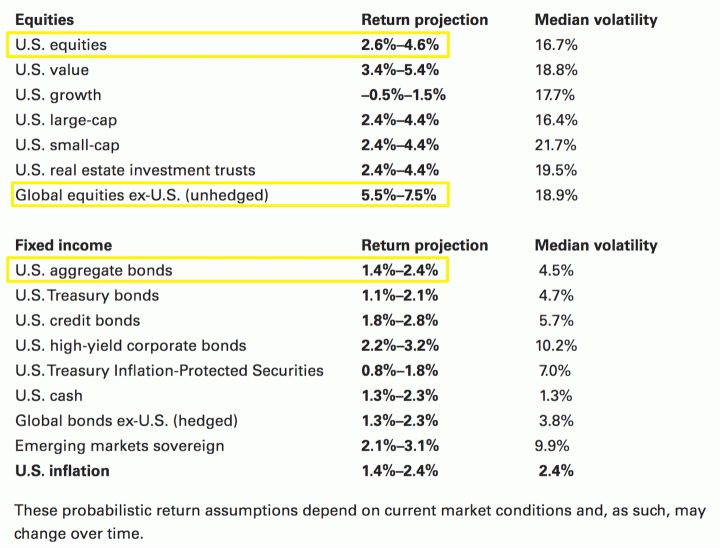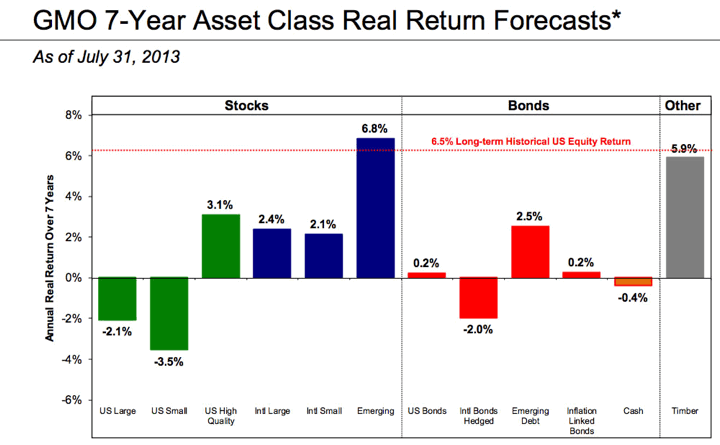The advisor-facing parts of brokerage firms are often of interest to DIY investors. In the June 2021 Market Perspectives article of Vanguard’s advisor site, they included their asset class return projections for the next 10 years:
Our 10-year, annualized, nominal return projections, as of March 31, 2021, are shown below. Please note that the figures are based on a 1.0-point range around the rounded 50th percentile of the distribution of return outcomes for equities and a 0.5-point range around the rounded 50th percentile for fixed income.

These projections should not be used for market timing! GMO offers similar outlooks. Here’s how well their 7-year projections turned out from 2013-2020:

- GMO forecast in 2013: US Large Cap equities will have a -2.3% annualized real return from July 2013 to July 2020. Reality today: The S&P 500 ETF (VOO) had an annualized real return of +9.9% from July 2013 to July 2020.
- GMO forecast in 2013: Emerging Markets equities will have a +6.8% annualized real return from July 2013 to July 2020. Reality today: The Emerging Market ETF (VWO) had an annualized real return of +2.3% from July 2013 to July 2020.
That is a huge difference in real-world cumulative returns after 7 years! If you fully believe the forecast, you might have sold all your stocks. If the forecast was correct, that $100,000 would have shrunk to $75,000. Instead, every $100,000 invested in the S&P 500 ETF (VOO) turned into $223,000 during that 7-year time frame. (Source: ETFReplay, SmartAsset)
Limited takeaways. There is some value in these predictions, but not that much:
- For equities, these outlooks partially assume that valuations will revert back toward their historical averages. Right now, valuations are higher than average due to low interest rates, and thus future returns for US stocks are lower than expected to be lower than average. Temper your expectations. Be prepared for both higher returns than the high end and lower returns than the low end.
- For bonds, current yields are the best predictor of future returns, and they are low. The possible range is much smaller. You’re just trying to barely keep up and get return of principal after inflation.
In the end, I am mostly posting this for historical reference. Vanguard’s estimate at least offers a range to help illustrate that it’s only slightly better than a wild guess (but about the best anyone can do). I hope to check back in after another 10 years and see how things panned out.
 The Best Credit Card Bonus Offers – 2025
The Best Credit Card Bonus Offers – 2025 Big List of Free Stocks from Brokerage Apps
Big List of Free Stocks from Brokerage Apps Best Interest Rates on Cash - 2025
Best Interest Rates on Cash - 2025 Free Credit Scores x 3 + Free Credit Monitoring
Free Credit Scores x 3 + Free Credit Monitoring Best No Fee 0% APR Balance Transfer Offers
Best No Fee 0% APR Balance Transfer Offers Little-Known Cellular Data Plans That Can Save Big Money
Little-Known Cellular Data Plans That Can Save Big Money How To Haggle Your Cable or Direct TV Bill
How To Haggle Your Cable or Direct TV Bill Big List of Free Consumer Data Reports (Credit, Rent, Work)
Big List of Free Consumer Data Reports (Credit, Rent, Work)
Speak Your Mind